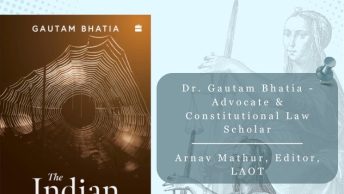The April 2007 issue of the Journal of Democracy has a feature on “India’s Unlikely Democracy” which includes an article by Pratap Bhanu Mehta titled “The Rise of Judicial Sovereignty.” Mehta’s piece reiterates some of the analysis that he has advanced in his previous writings, and has the advantage of being a short and succinct overview of the role of the judiciary in post-independent Indian politics. Apart from its helpful descriptive analysis, the article contains many of Mehta’s typically provocative and insightful comments. A sampling of these is included here, but the article as a whole is a good resource for those seeking an understanding of the important role played by the judiciary in India. Mehta makes the important point that “[a]lthough most studies of Indian politics pay almost no attention to the courts, disputes between the judiciary and the other two branches have been as important a fact about Indian political life as any.”
Mehta asserts that the Indian Supreme Court’s body of work is characterised by what he calls “three profound ironies” which he describes as follows:
“First, even as the nation’s most senior judicial panel engages in high-profile PIL interventions,
routine access to justice remains extremely difficult. India’s federal judicial system has a backlog of almost twenty million cases, thousands of prisoners are awaiting trial, and the average time it takes to get a judgment has been steadily increasing. There is a saying in India that you do not get punishment after due process—due process is the punishment.
The second irony is that even as the Supreme Court has established itself as a forum for resolving public-policy problems, the principles informing its actions have become less clear. To the extent that the rule of law means making available a forum for appeals, one can argue that the Court has done a decent job. To the extent that the rule of law means articulating a coherent public philosophy that produces predictable results, the Court’s interventions look less impressive. The third irony is that the Court has helped itself to so much power— usurping executive functions, marginalizing the representative process— without explaining from whence its own authority is supposed to come. In theory, democracy and constitutionalism can reinforce each other, but in practice their relationship is complex and even problematic. The question of where one begins and the other ends has taken on global significance in light of the widely observed trend toward “postdemocracy,” according to which representative institutions are losing power to nonelected centers of decision making the world over. In India, unelected judges have effectively replaced the notion of the separation of powers among three governmental branches with a “unitarian” claim of formal judicial supremacy. The concept of the rule of law is supposed to legitimate this claim, but whether judicial supremacy— either as such or as exercised by the Indian Supreme Court—actually upholds the rule of law remains an open question.” For me, the most insightful and simultaneously provocative part of the article was where Mehta makes the following claim:
“It is no accident that Indian constitutional law has been relatively unstable, or that the same courts which appear assertive in some areas seem weak in others: strong enough to spark the passage of many constitutional amendments meant to confound judicial rulings, but so easygoing
that no major politician has ever been charged in any of the numerous corruption cases that the Supreme Court has been supervising for years. The legitimacy and power that India’s judiciary does enjoy most likely flow not from a clear and consistent constitutional vision, but rather from its opposite. The Supreme Court in particular has given enough players enough partial victories to leave them feeling as if they have a stake in keeping the game of political give-and-take going. This, more than any ringing defense of principle, is the Court’s signal contribution to Indian democracy. (Emphasis added).”
My immediate reaction was to find this analysis persuasive, and I would be curious to know how others who have studied the Court’s work would react to such an assessment of its functioning. The one worry I have with such an interpretation, however, is that it seems to suggest that the Indian Supreme Court is a homogenous institution, whose members work in concert with each other in designing the gameplan of the organisation and that this ‘strategy’ was conceived and implemented by the institution as a whole. The practical reality of a 26 member institution whose membership is constantly in flux, and which sits in benches of 2 or 3 judges must make us a bit wary of accepting Mehta’s analysis uncritically. This is all the more so because Supreme Court judges are in theory supposed to work independently of each other, and each case is supposed to be decided on its own merits, by judges who have been randomly assigned to the bench deciding the particular case. The idea that judges adopt an overall strategy towards cases of a certain type, or that they discuss with other judges (who are not part of the particular bench) the approach or strategy that they should adopt in reaching a certain decision, would offend at least some of the accepted understandings about the judicial role. While the Court does have an overall institutional strategy on some issues, the fact is that it does not have very much control over its docket (unlike say the U.S. Supreme Court which controls access through grants of certiorari). While the Indian Supreme Court can control its docket (by deciding, for instance, not to grant SLPs in a certain category of cases) being simultaneoulsy a general court of appeal, its ability to do so is hampered.
I also worry that this analysis may lead to people becoming sanguine about individually egregious decisions of the Court, as they may think that the particular decision is just a part of a larger trend of cases that the institution is focusing on. This may lead, also, to a dilution of attention that should be focused on the justificatory reasoning advanced in support of each individual decision.The fact remains that given the nature of adjudicatory processes, decisions are made on an individualised, case-by-case basis, and the justification advanced for every decision should be capable of standing alone, instead of being understood as part of some overall utilitarian calculation.
The individualised character of litigation and adjudicatory processes makes the Court different from other political actors which can make policy decisions in the abstract. I believe that Mehta’s analysis, while compelling as a general hypothesis, does not pay sufficient attention to this aspect of the Supreme Court’s functioning.






Your blog really is excellent reading. I agree that much of the instability in Indian SC doctrine stems from the fact the court does not sit en banc like the US Supreme Court. Smaller benches allow a greater expression of the personal view of a judge, without the need to make them acceptable to other members of the Court. 2 judge benches also conveniently ‘clarify’ judgments of larger benches to suit themselves. Seervai famously quoted an American judge to the effect that the disrespect for precedent has assumed such proportions that they “are rapidly gravitating into the category of a second class railway ticket, good for that day and that train only!” I do not believe that our SC judges act in concert, in fact I believe the opposite to be true.
I point out another peril of judicial adventurism in a recent post-
http://rampalofthebailey.blogspot.com/2007/04/illegal-trafficking.html
All that you say notwithstanding, I think one can identify a pattern in the way our Supreme Court adjudicates issues. It can be characterized as taking the “midpoint” between the extremes. As an illustration, consider the controversial OBC reservation issue where the decision seems to take the midpoint in the sense that it legitimizes reservations for OBCs but then proceeds to undercut it by (i) removing the “creamy layer” [our national obsession with color?] and (ii) restricting the reservation to 50%.
I think this type of “midpoint” approach can be identified in other cases as well. It is apparent (to me) in the famous Kesavananda Bharati case as well where it accepted the right of Parliament to amend the constitution but then undercut it by saying that this did not extend to the “basic structure.”
The “midpoint” approach while quite right in some instances, I think, is way off-base in others. It leaves me frustrated, to be frank. But one implication is exactly what Pratap Bhanu Mehta suggests – it leaves everyone with a partial victory and feeling that they have a stake in the system. In the process – perhaps even without realising it explicitly – it enhances the Court’s own power within our political system.
My 5 paise worth on the subject.
Suresh.
Rampal of the Bailey (John Mortimer, I’m sure, would have appreciated the pun): Thanks for your input, and for referring us to your blog. I’ll follow your future posts keenly.
Suresh/Anonymous – I have a strong reaction to your comments, and I hope you will appreciate that I offer them in the spirit of rigorous academic exchange.
I am a bit wary of accepting analyses such as yours (which is the standard version offered by legal pundits nowadays to quell criticism of the judiciary) because I am not sure our Supreme Court is always motivated by Solomonic considerations of achieving a ‘midpoint’. On several issues, such as its attitude towards preventive detention or anti-terrorism for instance, the Supreme Court’s approach falls way short of any ‘midpoint’.
I am also unsure whether its intervention in Thakur or even in Kesavananda can be seen as striving for the ‘midpoint’ (whatever that is). The Thakur order has aroused indignation in some quarters because it is seen as unsettling many of the Supreme Court’s own precedents and taking an extreme position by questioning the foundational basis of quotas (which have been the law in India for over 60 years now). Mr. Venkatesan, for instance, would surely dispute your characterisation of the case.
Equally, when Kesavananda came out, many renowned jurists (including Seervai and Baxi) saw it as an absolute usurpation of constitutional power, not as seeking to achieve a balance (that perception came later). It is important to recognise that decisions which are now considered in a certain light may not have been so evaluated when they were pronounced. Who is to say which perception should count more?
What is needed, I believe, is a far more rigorous analysis of individual categories of decisions delivered by the Supreme Court instead of overall characterisations of the Court as having well-intentioned motives towards achieving a “midpoint.” To me, that doesn’t really say much, because this can be said of most institutions.
First, I am not a lawyer – just someone with an interest in law. You will have to forgive my daring to comment on this subject and excuse my errors. With that said, let me say the following.
I am a bit wary of accepting analyses such as yours (which is the standard version offered by legal pundits nowadays to quell criticism of the judiciary) because I am not sure our Supreme Court is always motivated by Solomonic considerations of achieving a ‘midpoint’.
It is not clear how what I have said can be used to quell criticism of the judiciary. Others will have to speak for themselves; I certainly have no such intention.
The Supreme Court, so far as I am concerned, does not have be motivated by – to quote you – Solomonic considerations of achieving a ‘midpoint.’ Its actual stated reasonings in the different cases may be very different. For my purposes, it is enough if the Court’s judgements can be understood as if they proceeded from a desire to achieve the ‘midpoint.’ There is a distinction here which I hope you appreciate. Furthermore, for Mehta’s point to be valid, it is not necessary that every judgement be explained in terms of achieving the midpoint; it is enough if a significant number of judgements have this feature.
The way to disprove me – or anyone else advancing a similar thesis – would be to show that the majority of cases cannot be rationalized in terms of achieving the midpoint. That may well be the case. As I said, I am not a lawyer and I cannot claim to have your depth of knowledge.
Suresh.
Dear Suresh,
I am sorry if I came across as wanting you to prove your legal credentials – that was not my intention, and I hope you don’t take that to mean that this blog solicits comments only from legally trained persons. I want to clarify this because I believe that discussions about the law, and especially public law, benefit immeasurably from the inputs of persons from different walks of life. So your inputs are most welcome, and please continue to engage with us.
I see the point of your distinction and understand its significance. I did not mean to question your motives – instead, I wanted to note that the point that you have made about the Court’s striving towards achieving a midpoint/balance has been advanced by several commentators as a reason why we should be more solicitious of the Court’s more erratic orders, because in general, the Court has good (and noble) intentions.
The reason I resist such characterisations more generally is because it is very difficult to define or agree upon what exactly constitutes a midpoint in the context of the complex social issues that the Court routinely engages with. The Court may well think that it is achieving a balance, but its own intepretation of what amounts to a balance may not be acceptable to the parties involved or the public, or may be subject to different nterpretations over time. To my mind, the Court should do its best to be faithful to the text of the law involved as well as that of the Constitution, and try and give them a plausible interpretation which also amounts to a reasonable solution to the problem posed before it in a particular case. We, as members of the public, should hold Courts to some objective standards of interpretation and adjudication, and not allow them to freely impose their own personal, subjective standards of what would be a ‘just’ solution to particular problems, remembering that notions of ‘justice’ are coloured by the class and other background prejudices of judges. Just look, for instance, at how the nature of ‘Public Interest Litigation’ has changed since its inception in the late 70s.
Our frustration with the representative institutions (Parliament and the Executive) must not make us lead to equally serious problems of relying too heavily on judges to administer the nation, a task they are institutionally capable of achieving. If we do not keep our judges in check, instances of clear judicial transgression of democratic boundaries (of which we have seen quite a few lately), will become more common.
I hope this clarifies my stance, and I look forward to more of your inputs,
Best,
Arun
Dear Arun,
Thanks for your remarks. I don’t think we are that far apart in our basic stance regarding the Supreme Court. Let me attempt a summary of my thoughts regarding Mehta’s point and our subsequent discussion.
If you look at my first post, I have already said that while the procedure of achieving the “midpoint” (which really amounts to balancing the claims of various parties) may be valid in some situations, it is not valid in others. In particular, I happen to think that in the two cases that I cite – Kesavananda and Thakur – that it is invalid.
Let us take the Thakur or the OBC quota case. I can perfectly well understand the Court adjudicating whether the use of quotas to achieve social justice violates the Constitution. But I am at a loss to understand the Court saying “Yes, quotas are okay but only upto a maximum of 50%.” Where does this 50% come from? The extent of quotas, I would think, can be decided only via the political process, viz., the Parliament. In this case, I do think that the Court has exceeded its brief. I have a similar stand with regard to Kesavananda where the Court seemed to say that Parliament can amend the constitution but not the “basic structure.” Since what constitutes the “basic structure” can only be decided by the Court, this ruling essentially puts a limit on Parliament’s powers without the Court telling us where this limit comes from. I was very impressed by Justice K. K. Mathew’s dissenting opinion in this case.
So, I don’t think we differ here. With regard to Mehta, I don’t think he is trying to say anything about the “rightness” or “wrongness” of the Court’s rulings. He is simply trying to understand the source of the Court’s powers as they exist today. I don’t think it can be contested that the Court does wield significant powers – much beyond its nominal duties of interpreting the Constitution. I think his basic point is that the Court, in effect, has acted as an arbiter of the social conflicts between various groups, and it is by acting as a “referee” – moreover, one which is seen roughly as a “neutral” one – that it has managed to arrogate to itself significant powers.
I have tried to argue that for Mehta’s point to be valid, it does not have to be the case that the Court perceives itself to be acting as a neutral referee. It’s actual stated reasons in the various cases may be very different but if one can understand the rulings in terms of the Court playing “referee”, then this will tell us how the Court came to gain so much power in the current setup.
As to the question, should the Court be acting as a referee – whether intentionally or unintentionally – my answer is NO. Social conflicts should be dealt with via the political process and not via the Court. There is, I think, a lot of danger by the court getting involved in the nitty-gritty of social conflict.
Hope this clarifies my stance. I apologize for the length of the comment.
Dear Suresh,
Thank you for that clear explanation – now that I understand your fuller view, I agree that we do have very similar positions on the overall issues involved. After I read your clarification, I re-read your original post, and see that you did outline this argument there as well. I seem to be missing whole chunks of text today (a similar ‘non’-reading of text occurred in the post relating to Jaffrelot’s comments), and i apologise for that. In any case, I think we are better off for your fuller explanation (I do not, however, offer this as an excuse ..).
I should clarify that I meant that courts are institutionally ‘incapable’ (in my last comment, I’d omitted the prefix ‘in’ leading to the opposite of what I sought to convey) of dealing with complex social problems. I see that this is the point you end with.
I suspect that we also agree that in exceptional cases, to preserve our democracy and other constitutional values, the Court may be justified in stepping beyond normal boundaries, but this should be rare, and only when the costs of not doing so are extremely high. Carving out such an exception may prevent us from sounding like unrelenting, overly stubborn Parliamentary Supremacists. That may also allow us to justify the 50% rule as well as the basic structure doctrines on grounds of pragmatism rather than principle.
Thanks again,
Arun